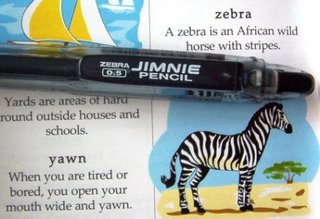A few months ago Pentel Ain won the inaugural Lead Cup so it’s time to do an official review of Pentel leads.
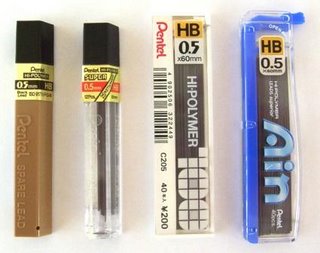
Pentel offer a great variety of graphite leads of many different thickness', hardness grades, quality levels, packaging, etc. For example in ordinary mechanical pencil refill leads they offer 0.3, 0.5, 0.7, 0.9 and 1.3mm thickness leads. In 1.3mm they offer hardness 2B, B, HB and H, but in 0.5mm leads the range of hardness offered expands to 4B through to 6H, including an F grade. They label their apparent quality levels as ‘Hi-Polymer’, ‘Super Hi-Polymer / Ain’, and ‘Premium Hi-Polymer’. Despite the name ‘Premium Hi-Polymer’ it appears that ‘Super Hi-Polymer / Ain’ is their top quality level lead.
As far as I can tell, Ain is just a marketing brandname, the Super Hi-Polymer leads are sold in a variety of containers, quantities per container (e.g. 12, 30 or 40 leads per container) and so on, some as ‘Super Hi-Polymer’ and some as ‘Ain’. All in all there’s an awful lot of apparent choice.
I wasn’t really sure about how to review leads, so I decided to spend a week writing with a selection of different hardness Ain 0.5mm leads. For comparison I also used Pentel Hi-Polymer 0.5mm HB lead. In theory the Ain leads are superior to Hi-Polymer.
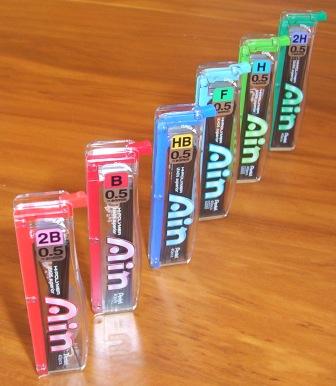
Well let’s get a few of the technicalities out of the way. Reliving the glory days of The Lead Cup, I put a few sticks of lead to the strength test. It was a clear victory, Ain HB is miles stronger than Hi-Polymer HB, so the cynic in me is wrong, there really must be two different formulations. Right then, what about between the hardness grades of Ain? There was a small but clear difference – as you might suspect, 2H was stronger than 2B.
So that’s strength, what about darkness? Just how much difference is there between the hardness grades? Basically I don’t think there is a lot of difference from one grade to the next on the scale, but if you skip a few out then there definitely is a difference in darkness. Anyone could tell 2B from 2H but its pretty difficult spotting the difference between 2B and B. I think they could probably delete every second hardness and not really affect anyone.
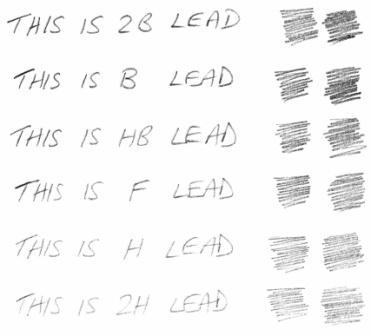
I recently had some difficulty with the diameters of some 0.7mm leads, so since my micrometer was handy I ran it across these 0.5mm leads. Grades 2B, B, HB, F, H, and 2H of Ain were all in the 0.565 to 0.57mm range, and the Hi-Polymer HB was 0.56mm. Strictly speaking, if you were correctly rounding to one decimal place, these are all 0.6mm leads, not 0.5mm.
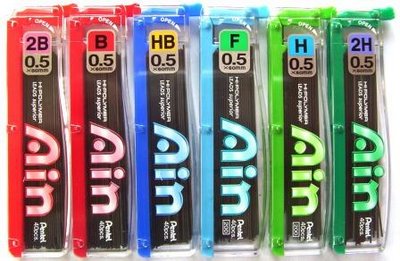
I must admit I’m rather taken by the Ain packaging. I like the clear sided gently curving container and the bright printed graphics.
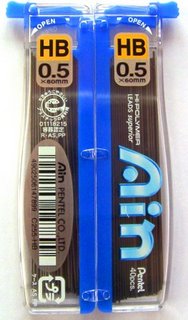
There appears to be a colour coding system in use for the spine and lever top - varying shades of red for the B grades of lead, greens for the H grades, and blues for the HB and F mid-grades. My containers have quite an array of fine print on the back of them relating to plastic recycling. There is some difference in the container markings, indicating it’s a changing thing at Pentel. The F container has no recycling information on it, but all the others do. Now I’m not much of an expert, but as far as I can tell, the marks indicate they are recyclable, and are in fact made from some recycled material – polypropylene and whatever ‘AS’ is. I am guessing its some sort of acrylic-styrene, but I can’t find any reference to what the code ‘AS’ stands for in the plastics recycling schemes. But then again I don’t read Japanese.

There are 40 pieces of 60mm long lead in each Ain container. You flip the top open by pressing down on the lever with your thumb. Then you give the container a bit of a shake to dispense some lead. Actually this is not really the best. Sometimes you have to give it quite a good shake to get some leads out, and you can get one, or 2 or 3 at a time. Putting surplus leads back in can also be a bit fiddly. I get the impression it’s supposed to be a design that dispenses leads individually, but often lets a few others sneak out.
Now, what about actually writing with the leads! First up I put on my testing hat and did a blind test on the Hi-Polymer HB and Ain HB. Could I tell a difference when just writing under ordinary circumstances? Well, basically no. I had Ain in one pencil and Hi-Polymer in another and swapped them around a few times. I couldn’t tell the difference. Ain was of course stronger, it was undefeated in the strength tests of the Lead Cup, but that doesn’t mean Hi-Polymer was weak and breaking all the time, because it wasn’t. Ain has exceptional strength, but Hi-Polymer is certainly strong enough for normal use.
About 10 years ago I did a year long part-time course in quality assurance. I always remember the time we did a class test on Coke vs Pepsi. This is apparently a standard technique in the food industry. You give the test group three samples each – 2 of one thing and 1 of another and ask them to pick the odd one out. So, my class of 20 or so students were each given three little taster cups of cola – 2 were Coke and 1 was Pepsi. I mean how hard could it be? They taste completely different, don’t they? Well, statistically speaking my class couldn’t tell them apart. Pretty much 1/3rd of the class chose sample A as the odd one out, 1/3rd chose B and 1/3rd C. The lecturer said he had never had a class that could tell them apart, so as much as I can’t believe it, it appears there is no difference between Coke and Pepsi to the taste-buds of the general public. Crazy stuff.
Now note that I said general public. In my class there were two employees from the local Coca-Cola bottling plant. One worked in the laboratory and the other was a genuine ‘taste-tester’. The lady from the laboratory could easily pick the Pepsi by taste, we all watched as she did the three way test a few times and could immediately choose the odd-one out. Then it was the taste-testers turn. He was of course stunned at how useless we all were, a bunch of morons unable to tell Coke from Pepsi. I kid you not, he could tell them apart by sight from a few metres away. Blindfolded he could tell them apart by listening to them – the different levels of carbonation making different bubble sounds! Blindfolded and fingers in ears he could sniff them and tell them apart by smell. So, I’m sure the lead experts at Pentel can tell Hi-Polymer from Ain in the blink of eye, but as for the rest of us….
Well that’s Hi-Polymer out of the way, what about the different grades of Ain? I spent the rest of the week using two identical pencils, one with Ain HB in it and the other with a different grade – 2H, F or 2B.
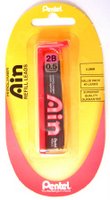
All the grades are good smooth writing. 2B was slightly smoother than the harder grades, particularly 2H, and if you rotated the pencil to start on a new part of the leads chisel point then you can tell that the harder the grade the more it dug into the paper and took longer to wear down. When I was using the 2H lead I did keep wanting to press harder to darken things up. I put a page of mixed 2H and HB writing through the photocopier and the 2H copies noticeably lighter. Grade 2B definitely wore down faster than HB, so you get more words per stick of lead with HB. I’d guess about a 25% difference. Actually 2B isn’t all that much darker than HB with normal writing, as HB is already quite dark. I did occasionally notice a couple of specks of graphite dust on the page when writing with 2B, and that didn’t happen with the others. Overall I think there is more general difference in 2H to HB than HB to 2B. What about that most unusual of grades, F? It’s really quite hard to tell any difference from HB. I recall a drawing tutor saying that F had the hardness of H and the darkness of HB, but it’s a close call.
Footnote:
Just to clarify the situation, I asked Pentel customer services if there was any difference in the actual leads of Ain and Super Hi-Polymer. They replied, “
There is no real difference in the leads, however, the AIN leads are stronger and darker than our original Hi polymer leads.”
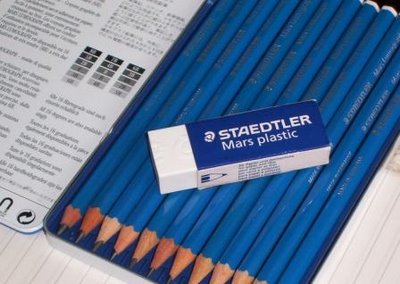
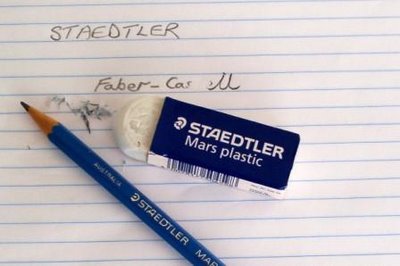 It is a reasonably large eraser which has some good and bad points. On the good side, you can get a firm grip on it which makes things easy if you have a lot of erasing to do, and you can erase an awful lot before you will need to buy a new one. So there’s slightly less need to panic during your exam when you suddenly realise you have to rub out half your wonderful design. On the bad side, whilst it starts out with nice square edges and a square end, you can’t really keep a sharp edge or fine point on this eraser so it is a bit of a blunt instrument. You definitely need an erasing shield if you have some fine erasing to do. Of course chopping the rounded end off the eraser is an option, and I have resorted to this every now and then.
It is a reasonably large eraser which has some good and bad points. On the good side, you can get a firm grip on it which makes things easy if you have a lot of erasing to do, and you can erase an awful lot before you will need to buy a new one. So there’s slightly less need to panic during your exam when you suddenly realise you have to rub out half your wonderful design. On the bad side, whilst it starts out with nice square edges and a square end, you can’t really keep a sharp edge or fine point on this eraser so it is a bit of a blunt instrument. You definitely need an erasing shield if you have some fine erasing to do. Of course chopping the rounded end off the eraser is an option, and I have resorted to this every now and then.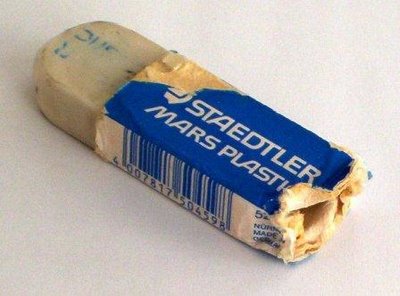 Speaking of the compound, as you erase away, the waste does twist itself up into long strands which are easily removed, just like Staedtler claim. They also claim it is good for removing scuff marks from vinyl floors, marks from light switches and wallpaper, cleaning nail files and a whole lot of other things. I can vouch for the first few – but no idea about the nail file! The compound is relatively odourless – I recall “smelly” erasers being very popular when I was a little fellow at primary school.
Speaking of the compound, as you erase away, the waste does twist itself up into long strands which are easily removed, just like Staedtler claim. They also claim it is good for removing scuff marks from vinyl floors, marks from light switches and wallpaper, cleaning nail files and a whole lot of other things. I can vouch for the first few – but no idea about the nail file! The compound is relatively odourless – I recall “smelly” erasers being very popular when I was a little fellow at primary school.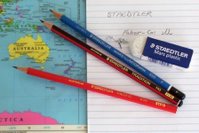 Footnote: Drafts of this review were prepared with a Staedtler (Australia) Pacific 830 grade HB wooden pencil, assisted by Dux 1128-NB sharpener, and of course Staedtler Mars Plastic 526 50 eraser.
Footnote: Drafts of this review were prepared with a Staedtler (Australia) Pacific 830 grade HB wooden pencil, assisted by Dux 1128-NB sharpener, and of course Staedtler Mars Plastic 526 50 eraser.
 My converters arrived just as pictured, without any instructions. You can also see they are rather different in shape and length to an ordinary Parker ballpoint refill, so exactly how would they fit? They were advertised as allowing you to convert most Parker type pens to pencils. I easily figured out they are a push-top ratchet mechanism and the top pulls off to allow access to the lead chamber.
My converters arrived just as pictured, without any instructions. You can also see they are rather different in shape and length to an ordinary Parker ballpoint refill, so exactly how would they fit? They were advertised as allowing you to convert most Parker type pens to pencils. I easily figured out they are a push-top ratchet mechanism and the top pulls off to allow access to the lead chamber.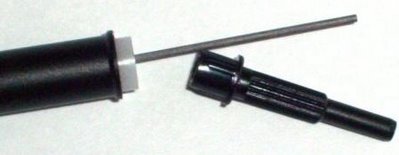 So, first up I grabbed a Parker pen and quickly realised it wasn’t going to work. The spring that fits on the front of the pen refill has to be removed for the converter to fit. My particular Parker’s spring appeared to be permanently affixed inside the pen barrel and I just couldn’t remove it. So then I tried another pen, a non-Parker but one that I could get the spring out of the barrel. But again it was all to no avail. It was actually a twist action pen and I just couldn’t get it to operate the converter mechanism.
So, first up I grabbed a Parker pen and quickly realised it wasn’t going to work. The spring that fits on the front of the pen refill has to be removed for the converter to fit. My particular Parker’s spring appeared to be permanently affixed inside the pen barrel and I just couldn’t remove it. So then I tried another pen, a non-Parker but one that I could get the spring out of the barrel. But again it was all to no avail. It was actually a twist action pen and I just couldn’t get it to operate the converter mechanism. So by slowly chopping small amounts off the top stem of the converter I found a length that made it work, and Voila!
So by slowly chopping small amounts off the top stem of the converter I found a length that made it work, and Voila! It all woks fine as a standard push top ratchet mechanical pencil, but the lead sleeve is not retractable. So overall, not a bad idea, but a little difficult to get to work in the real world. If you had a pen that you really liked and wanted it to be a pencil, then there’s a chance this converter might just work for you.
It all woks fine as a standard push top ratchet mechanical pencil, but the lead sleeve is not retractable. So overall, not a bad idea, but a little difficult to get to work in the real world. If you had a pen that you really liked and wanted it to be a pencil, then there’s a chance this converter might just work for you. 
 One of my recent acquisitions from a bout of eBay madness is a 1948 catalogue from Autopoint. I’ve got a bit of an interest in general history and I like these old catalogues, magazines and so on as they are a glimpse back into the past. I like to compare them to today and think how things have evolved, and I get to pursue two interests at the same time – history and pencils. I bought my 1948 catalogue from a seller in Australia, and it came with a letter from Autopoint to an Australian company that was enquiring about their products. This is the text of the letter:
One of my recent acquisitions from a bout of eBay madness is a 1948 catalogue from Autopoint. I’ve got a bit of an interest in general history and I like these old catalogues, magazines and so on as they are a glimpse back into the past. I like to compare them to today and think how things have evolved, and I get to pursue two interests at the same time – history and pencils. I bought my 1948 catalogue from a seller in Australia, and it came with a letter from Autopoint to an Australian company that was enquiring about their products. This is the text of the letter:





 Well let’s get a few of the technicalities out of the way. Reliving the glory days of The Lead Cup, I put a few sticks of lead to the strength test. It was a clear victory, Ain HB is miles stronger than Hi-Polymer HB, so the cynic in me is wrong, there really must be two different formulations. Right then, what about between the hardness grades of Ain? There was a small but clear difference – as you might suspect, 2H was stronger than 2B.
Well let’s get a few of the technicalities out of the way. Reliving the glory days of The Lead Cup, I put a few sticks of lead to the strength test. It was a clear victory, Ain HB is miles stronger than Hi-Polymer HB, so the cynic in me is wrong, there really must be two different formulations. Right then, what about between the hardness grades of Ain? There was a small but clear difference – as you might suspect, 2H was stronger than 2B. I recently had some difficulty with the diameters of some 0.7mm leads, so since my micrometer was handy I ran it across these 0.5mm leads. Grades 2B, B, HB, F, H, and 2H of Ain were all in the 0.565 to 0.57mm range, and the Hi-Polymer HB was 0.56mm. Strictly speaking, if you were correctly rounding to one decimal place, these are all 0.6mm leads, not 0.5mm.
I recently had some difficulty with the diameters of some 0.7mm leads, so since my micrometer was handy I ran it across these 0.5mm leads. Grades 2B, B, HB, F, H, and 2H of Ain were all in the 0.565 to 0.57mm range, and the Hi-Polymer HB was 0.56mm. Strictly speaking, if you were correctly rounding to one decimal place, these are all 0.6mm leads, not 0.5mm. I must admit I’m rather taken by the Ain packaging. I like the clear sided gently curving container and the bright printed graphics.
I must admit I’m rather taken by the Ain packaging. I like the clear sided gently curving container and the bright printed graphics. 




